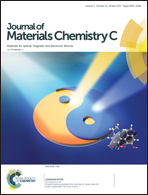Crystal structure, ferroelectricity and polar order in a Ba4R2Zr4Nb6O30 (R = La, Nd, Sm) tetragonal tungsten bronze new system†
Abstract
It has become very important to search for Pb-free ferroelectric new materials because of increasing environmental concerns, and the tungsten bronze family might provide great potential for this challenge due to the various possibilities of structural tailoring. In the present work, a zirconate niobate ferroelectric new system Ba4R2Zr4Nb6O30 (R = La, Nd, Sm) with a filled tetragonal tungsten bronze structure has been synthesized and investigated. The ferroelectricity and polar order are characterized together with the crystal structure. The present materials show a crossover from relaxor to normal ferroelectric features upon increasing the A-site ionic radii difference (Δr). The relaxor behavior in Ba4La2Zr4Nb6O30 is associated with incommensurate modulation, while commensurate structural modulation dominates the normal ferroelectric transition in Ba4Nd2Zr4Nb6O30 and Ba4Sm2Zr4Nb6O30. Compared with titanate niobate tungsten bronzes, the present materials exhibit a stronger relaxor nature. The ferroelectric transition in Ba4Nd2Zr4Nb6O30 and Ba4Sm2Zr4Nb6O30 shows first order features with an unusually large thermal hysteresis (>100 K), and is followed by a low temperature dielectric relaxation. Micro polar regions are detected for Ba4La2Zr4Nb6O30 under piezoresponse force microscopy (PFM), while the coexistence of macro ferroelectric domains and micro polar regions is observed in the low temperature relaxation region for Ba4Nd2Zr4Nb6O30 and Ba4Sm2Zr4Nb6O30, and the micro polar regions can grow into the macro domains under a high electric field. An abnormal decrease is observed at lower temperatures in the curve of remanent polarization vs. temperature for Ba4Nd2Zr4Nb6O30 and Ba4Sm2Zr4Nb6O30, which is attributed to the disruption of the ferroelectric polar order by the micro polar regions appearing at the same temperature region. The present new system is expected to be a promising candidate for Pb-free ferroelectric materials.



 Please wait while we load your content...
Please wait while we load your content...